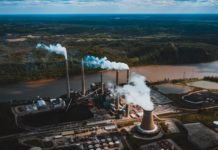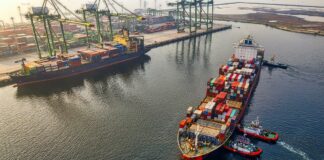What do tech giant Microsoft, oil giant Exxon and financial tech firm Ripple have in common? Along with many other big corporations, they all have a climate strategy that involves investing in carbon removal technologies. But what exactly are the technologies currently in development, and how likely are they to help the climate crisis in the near future?
Direct air capture (DAC) /direct air carbon capture and storage (DACCS)
Direct air capture works exactly as the name suggests: by taking CO2 directly from the air so that it no longer contributes to global warming. There are two ways to do it: by passing air through a liquid to remove the CO2, or by using a solid material to absorb it. The captured CO2 can then be permanently stored underground, or used in some way.
Does it work yet?
There are currently 19 DAC plants operating worldwide, but all on a small scale. The technology hasn’t yet been shown to work on a large scale, but a large plant is being developed in the United States and could be up and running as early as 2024.
The issues
- Cost. Capturing CO2 gas directly from a factory or power station is relatively straightforward because it is in concentrated form. In the atmosphere, CO2 is much more dilute and therefore requires more energy to capture.
- What to do with the captured CO2. Some of the DAC plants already in operation are selling it for reuse (for example, in manufacturing building materials or carbonating fizzy drinks). But using it means re-releasing it into the atmosphere. Getting it out of the atmosphere for good means compressing it and storing it underground, which is currently an energy-intensive process.
Bioenergy with carbon capture and storage (BECCS)
Power company Drax is pioneering this technology with two pilot facilities and has described BECCS as “the most scalable negative emissions technology available today”. BECCS involves capturing, cooling and treating flue gas, then using a chemical reaction to extract the CO2 from it. The CO2 is then stored underground; the Drax plan is to use pipelines to transport it for storage under the North Sea.
This technology is considered carbon negative because the flue gas comes from burning sustainably sourced biomass (to generate carbon-neutral electricity). The theory is that because the forests have absorbed carbon dioxide as they grow, then keeping the carbon from combusting them out of the atmosphere will result in net negative emissions.
Does it work yet?
BECCS is already in use, but has not yet been deployed at scale.
The issues
A 2019 study from Imperial College offered a “reality check” on BECCs, describing it as a group of technologies rather than one single technology. Variables include:
- The type of biomass feedstock (wood, grasses, sugar crops, etc);
- The quality of the feedstock (moisture content, what is in the mixture, etc);
- How it is collected;
- How it is transported;
- The intended outcome of the process: is the biomass being turned into biofuel or electricity?
- The details of the process itself.
This means a lot of variation in the energy efficiency of the process and in how much CO2 is actually removed from the atmosphere.
Another serious issue is the amount of land that would be required to deploy this technology at scale. The resulting competition for available land could lead to habitat loss for animals and a reduction in the amount of land available for food crops.
Sustainable aviation fuel (SAF)
The UK government is hoping for a technology that will enable “guilt-free flying”, which is why last spring it launched a £15 million prize fund for projects to create a low-emission plane fuel. In October 2021, as part of its net zero strategy, it pledged a further £180 million for sustainable aviation fuel plants.
The theory behind sustainable aviation fuel is that, like all biofuels, it is created from biomass that has absorbed carbon from the atmosphere as it grows.
Does it work yet?
In December 2021, United Airlines became the first airline to operate a passenger flight with an engine running on 100% SAF. Most of the time, SAF is mixed with normal jet fuel to reduce emissions per flight. A big advantage of SAF is that you can use this mixture without needing to make any modifications to the plane’s engine.
The issues
- Cost. SAF has been estimated to cost roughly 4-5 times as much as normal jet fuel. (But it is worth remembering that the cost of normal jet fuel is kept artificially low because the 1944 Chicago Convention makes it exempt from tax. A different tax structure could drastically change the pricing differentials, and the United States recently brought in a tax credit for SAF.)
- Supply. There just isn’t enough SAF available for all the airlines to use it. This means that it makes up less than 1% of jet fuel.
Supporting or enhancing natural carbon sinks
It is estimated that roughly half of emissions caused by human activity are absorbed by the earth’s natural carbon sinks in our forests, oceans and wetlands. It may not count as a technology as such, but many large businesses are using investment in tree-planting or peat conversation projects as a way to offset their existing emissions on the road to net zero.
Does it work yet?
Yes. The earth’s natural ability to absorb greenhouse gases is the reason why the Industrial Revolution didn’t immediately lead to runaway climate change.
The issues
The earth has limits. As we explained in our piece on the concept of negative carbon, there isn’t enough land on earth to offset the current level of emissions – even if we pretend we don’t need the land for anything else, like feeding or housing people. There is already concern that the race to grab land for offsetting is causing problems such as habitat loss or the loss of land previously dedicated to farming. Another concern raised by the Intergovernmental Panel on Climate Change (IPCC) is the permanence of these natural carbon sinks. Changes such as soil degradation, melting permafrost or forest fires can unlock the carbon stored and release it back into the atmosphere.
Conclusion
Nothing has substantially changed since the IPCC’s 2018 report on carbon removal technologies:
“As of yet, such techniques have not been proven to work on a large scale and, depending on how they are implemented, could compete for land and water.”
Based on the technology we currently have, the only route to avoiding runaway climate change is to cut our emissions. Reducing emissions should be the first and main focus of any business carving out a net zero strategy.












